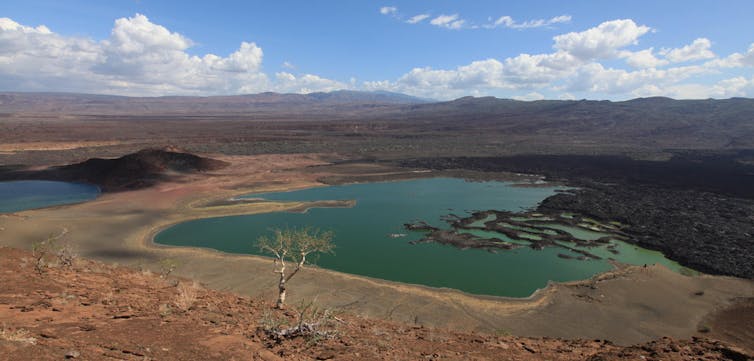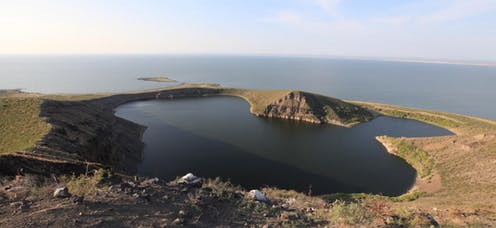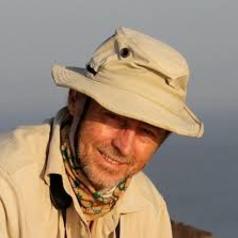Lake Turkana is the world’s largest desert lake. Located in Kenya’s remote northern arid lands, it is the most saline of Africa’s great lakes, and its vast aquatic resources contribute to the livelihoods of over 300,000 people, including pastoralists, fishermen and tourism operators. Its ecology supports a host of local and migratory bird and wildlife populations.
It’s also home to unique fossil and archaeological discoveries. In 1973, Sibiloi National Park was created on the north-eastern lakeshore to conserve these remarkable discoveries that have contributed so much to our understanding of human evolution. And in 1983 and 1985, the lake’s South and Central Islands were designated national parks because of their outstanding wildlife breeding habitats, notably for the Nile crocodile.
These three national parks were inscribed as a World Heritage Site in 1997 for their “geological and fossil records” and “diverse aquatic and terrestrial habitats”.
There are 1,092 UNESCO World Heritage sites in the world, five of which are within Kenya. Sites are selected for their outstanding cultural value, or outstanding natural value, or a combination of both assets. Once inscribed, the sites are protected according to local legislation and international treaties.
It would seem that this status would offer the lake good protection against major threats. But that’s not been the case. The lake’s national parks are now on the World Heritage “In Danger” list, a result of Ethiopia’s developments on the Omo river – which feeds the lake – and poor management of the parks by Kenya.
Keeping heritage sites safe
193 countries worldwide are party to the World Heritage Convention that came into force in 1975. The aim is to protect globally outstanding cultural and natural sites, and conserve them for future generations. Both Kenya and Ethiopia are state parties to this Convention.

Lake Turkana. Sean Avery
Under the convention guidelines, state parties are obliged to submit reports every six years on each of their World Heritage sites. If a site comes under threat, the World Heritage Committee can initiate the agreed process of “reactive monitoring” – an independent mission to review and produce a report on the state of conservation of the site. If the site is found to be facing danger, the mission can recommend it be placed on the “List of World Heritage in Danger”.
If this listing is decided upon, and if the danger can be remedied, the State Party can ask for help from the World Heritage Fund. But, if the site is irretrievably damaged, the Committee can decide to delete the site from the list altogether.
Why the lake was put on the danger list
The World Heritage Committee first expressed strong concerns about the lake’s sustainability seven years ago. Threats were identified as the Gibe dams and irrigation plantation developments on Ethiopia’s Omo River. More than 80% of the lake’s freshwater inflow is provided by the Omo River and so these projects affect the lake’s ecology.
The committee requested that Ethiopia suspend construction works on the Gibe III dam and submit assessments on the dam and irrigation development plans. Ethiopia and Kenya were each requested to share their views, and in its report to the committee Kenya shared the same concerns. As a result a reactive monitoring mission was invited to Kenya.
Over the years – despite annual exchanges between the World Heritage Committee, Kenya and Ethiopia – Ethiopia has not acted on the various requests issued by the Committee, continuing with development projects without conducting a strategic environmental assessment. The filling of Gibe III’s vast reservoir was completed in December 2016 and the full water demands and downstream effects of irrigation schemes are still not known.
Kenya too has been lax. It hasn’t implemented recommendations to deal with poaching, illegal fishing, and livestock grazing in the Lake Turkana National Parks.
For the last couple of years the committee has expressed regrets, included notes, and made requests from both countries, but there have been no decisions in tackling the lake’s threats.
In its most recent session, the committee warned that the Gibe III dam had already heavily disrupted the lake’s seasonal patterns, and that this would adversely affect the fish population and the livelihoods of local fishing communities.
As a result, it was declared that Lake Turkana National Parks’ outstanding universal values are in danger and it was decided that the site should be inscribed on the List of World Heritage in danger.
Next steps
The World Heritage Committee has now requested Kenya to invite a reactive monitoring mission to review what’s happened and to propose a way forward to remove the Lake Turkana National Parks from the “List of World Heritage in Danger”.
That mission would aim to develop a set of corrective measures in consultation with both Kenya and Ethiopia. If that mission takes place, its report will be reviewed at the Committee’s 43rd session in 2019.
The impact of the intervention might not amount to much. Warnings about the effects of Omo river developments were sounded decades ago, and yet Gibe III is operational, and Gibe IV dam and irrigation scheme developments are progressing. Protests have seemingly been futile.
The lake inflow hydrology has already changed. That means that nutrient inflows and their distribution through the lake have also been affected. Changes in the lake’s ecological diversity will, in turn, affect the lake fisheries.
Nevertheless, the commendable efforts of bodies like the World Heritage Committee need to be sustained. The management of the Lake Turkana National Parks can certainly be improved. The county governments should be involved, and the World Heritage Fund can potentially assist. The entire lake will benefit as a result.
And there is still time for Ethiopia to review its ambitious thirsty irrigation development plans in the lower Omo, admit the impacts, and reconsider the worth of sacrificing unique natural capital, and perhaps restore meaningful ecological floods into the lake too.



 Fungi are among the planet’s most important organisms — yet they continue to be overlooked in conservation strategies
Fungi are among the planet’s most important organisms — yet they continue to be overlooked in conservation strategies  What’s so special about Ukraine’s minerals? A geologist explains
What’s so special about Ukraine’s minerals? A geologist explains  As the Black Summer megafires neared, people rallied to save wildlife and domestic animals. But it came at a real cost
As the Black Summer megafires neared, people rallied to save wildlife and domestic animals. But it came at a real cost  The UK is surprisingly short of water – but more reservoirs aren’t the answer
The UK is surprisingly short of water – but more reservoirs aren’t the answer  GesiaPlatform Launches Carbon-Neutral Lifestyle App ‘Net Zero Heroes’
GesiaPlatform Launches Carbon-Neutral Lifestyle App ‘Net Zero Heroes’  Extreme heat, flooding, wildfires – Colorado’s formerly incarcerated people on the hazards they faced behind bars
Extreme heat, flooding, wildfires – Colorado’s formerly incarcerated people on the hazards they faced behind bars  Citi Sets Bullish 2026 Target for STOXX 600 as Fiscal Support and Monetary Easing Boost Outlook
Citi Sets Bullish 2026 Target for STOXX 600 as Fiscal Support and Monetary Easing Boost Outlook  Europe Confronts Rising Competitive Pressure as China Accelerates Export-Led Growth
Europe Confronts Rising Competitive Pressure as China Accelerates Export-Led Growth  Asia’s IPO Market Set for Strong Growth as China and India Drive Investor Diversification
Asia’s IPO Market Set for Strong Growth as China and India Drive Investor Diversification  Ukraine minerals deal: the idea that natural resource extraction can build peace has been around for decades
Ukraine minerals deal: the idea that natural resource extraction can build peace has been around for decades  Lake beds are rich environmental records — studying them reveals much about a place’s history
Lake beds are rich environmental records — studying them reveals much about a place’s history 
































